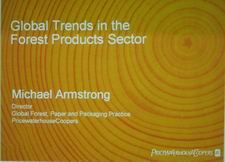Wood Product Future Demand
By 250 News
 What does the rest of the world want when it comes to forest products? That is the question Michael Armstrong of Price Waterhouse Coopers is always trying to answer.
What does the rest of the world want when it comes to forest products? That is the question Michael Armstrong of Price Waterhouse Coopers is always trying to answer.
In a presentation to delegates at a forum in Prince George this morning, Armstrong says the industry will remain challenged, as the demand for fibre moves to Asia and the supply is increasingly coming from South America. Armstrong says it is not unusual for the fibre mill to be located in South America, while the actual pulp mill it supplies is located in Asia.
Armstrong says there is demand for pellets, and B.C. has the capacity for a dozen pellet plants, but again, the supply of fibre will become an issue. The supply matter could shift dramatically as Russia improves its infrastructure. Russia has 20% of the world’s forests, but is only producing the fibre at 50 – 60% of capacity.
Consultant Bernard Fuller echoed those concerns saying there are four factors which will shape the world’s plywood market:
- Supply of timber
- Exchange rates
- Manufacturing costs
- Flexibility to market changes, He says if there is a shortage of plywood, some markets will switch to MDF
He also predicts the use of plywood will continue to slip as it has dropped from 46% to 33% as markets move to OSB.
Fuller says when it comes to panel board, the markets were very favourable for the past three years, and as is typical, the markets have slipped. “What is unusual this time is that North America is the exception.” The rest of the world is seeing increases in supply and demand. The North American Market is in a pit, says Fuller because of the U.S. housing market. “If I had done this presentation three months ago, I would have been more optimistic about the recovery starting in 2008, but with the drop in the sub prime mortgage markets, that has hurt the confidence of the buyers. You can expect to see monthly housing starts of 1.2 or 1.3 million which is very low, but keep in mind, employment remains very high, and mortgage rates are dropping. It might take another 9-12 months to see that inventory of housing absorbed, so I expect to see things start to improve in the second half of next year.”
Fuller says plywood producers must keep their eye on the Canadian market as the housing starts in Canada have been very high, levels he indicates may be inflated and he is “Waiting for the other shoe to drop”.
On the positive side, Price Waterhouse Coopers’ Michael Armstrong says the fact Canadian mills are modern, able to adapt to shifts in markets, and are viewed as having good forest practices are all factors which play in our favour. Fuller says the Chinese plywood production will peak in the next decade then drop because of production costs, and the quality of Russian wood will limit the uses for those logs. As for South America, Fuller says timber supply will be an issue as there is growing environmental pressure.
Previous Story - Next Story
Return to Home









Weather the next ten years and then we'll be doing okay?
I am not so sure about that. Ten years is a long time and, as can be seen from the plywood/OSB situation, things change.
It appears that a likely scenario will be that we have hit a peak demand that will certainly not be reached again in the next two or so generations (40+ years), a drop will occur due to global demand shifts; an additional drop will occur on the supply side as well as loss of feedstock in the field works its way through the system (MPB), an increase of demand may happen in the USA, a further shift will occur on the supply side in shifting away from traditional suppliers for the US to eastern Canada and other international suppliers.
Solution? Hire some thinkers who can work on shifting the economy of BC to more value added wood fibre and more non-forest industry based manufacturing/services.
I suggest we outsource that problem to consultants in some other countries….
;-)
BTW, do these reports just deal with identifying the nature of the business environment, or do they also recommend solutions?